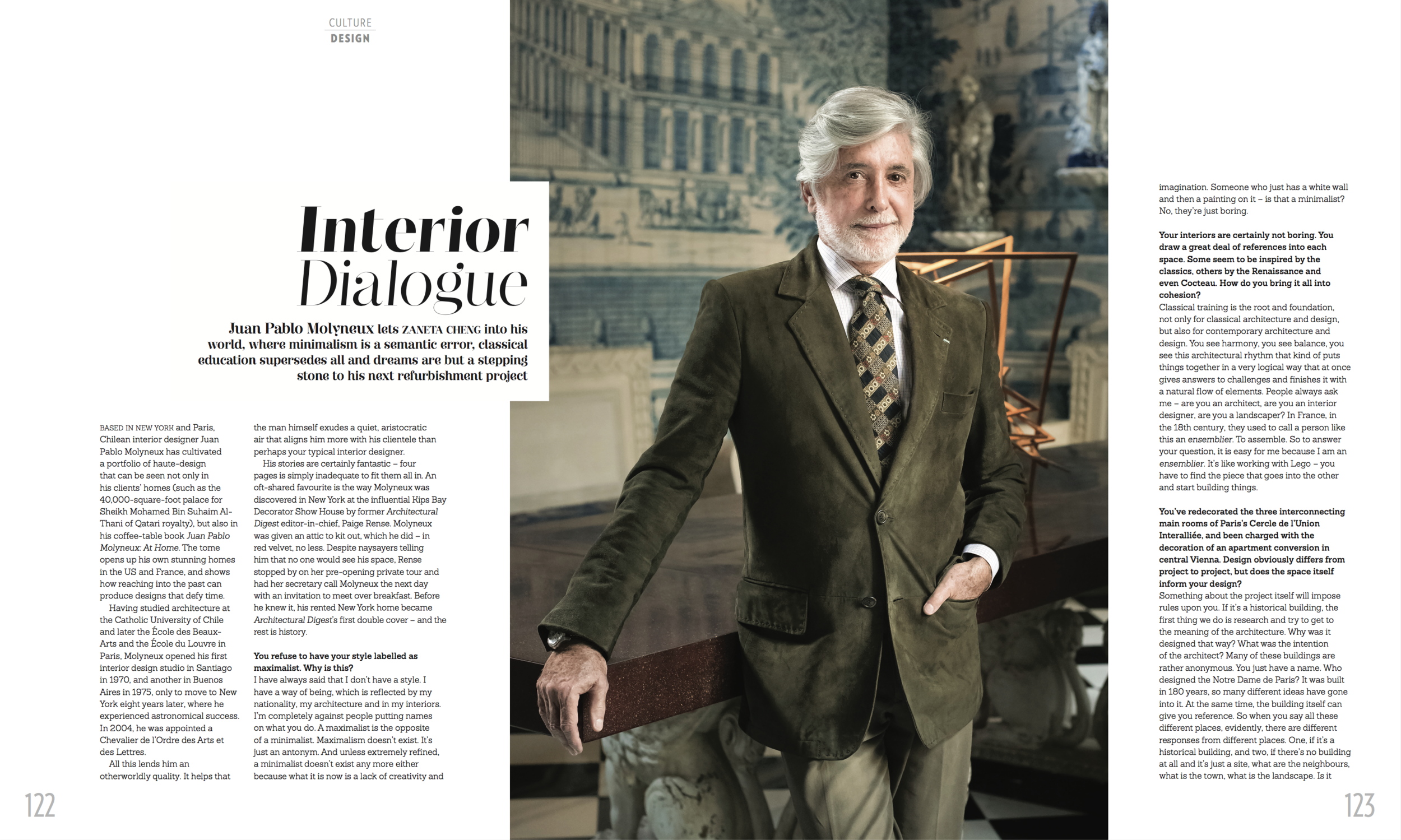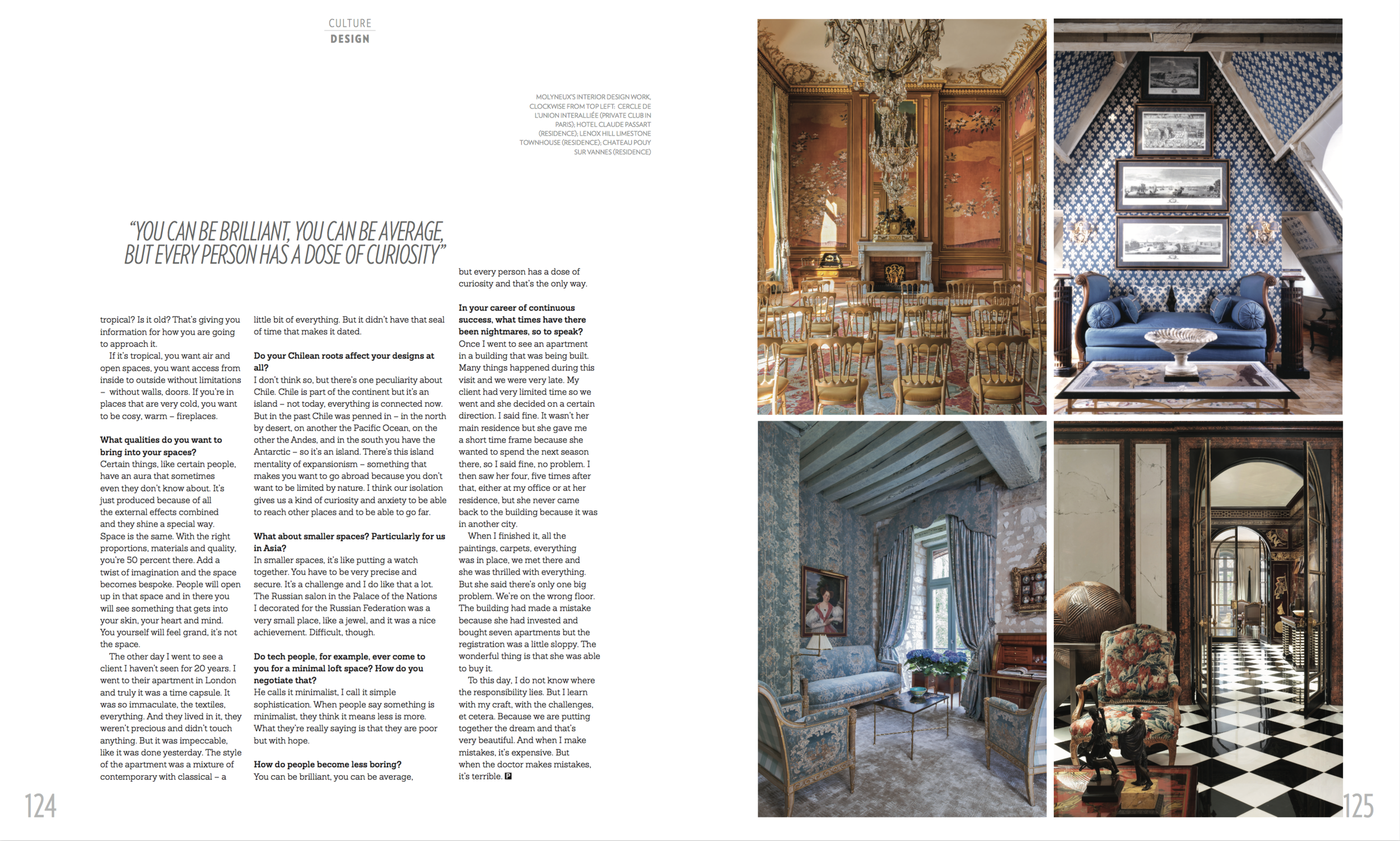JP Molyneux | Prestige Hong Kong (FEB 18)
Juan Pablo Molyneux lets zaneta cheng into his world, where minimalism is a semantic error, classical education supersedes all and dreams are but a stepping stone to his next refurbishment project
Based in New York and Paris, Chilean interior designer Juan Pablo Molyneux has cultivated a portfolio of haute-design that can be seen not only in his clients’ homes (such as the 40,000-square-foot palace for Sheikh Mohamed Bin Suhaim Al-Thani of Qatari royalty), but also in his coffee-table book Juan Pablo Molyneux: At Home. The tome opens up his own stunning homes in the US and France, and shows how reaching into the past can produce designs that defy time.
Having studied architecture at the Catholic University of Chile and later the École des Beaux-Arts and the École du Louvre in Paris, Molyneux opened his first interior design studio in Santiago in 1970, and another in Buenos Aires in 1975, only to move to New York eight years later, where he experienced astronomical success. In 2004, he was appointed a Chevalier de l’Ordre des Arts et des Lettres.
All this lends him an otherworldly quality. It helps that the man himself exudes a quiet, aristocratic air that aligns him more with his clientele than perhaps your typical interior designer.
His stories are certainly fantastic – four pages is simply inadequate to fit them all in. An oft-shared favourite is the way Molyneux was discovered in New York at the influential Kips Bay Decorator Show House by former Architectural Digest editor-in-chief, Paige Rense. Molyneux was given an attic to kit out, which he did – in red velvet, no less. Despite naysayers telling him that no one would see his space, Rense stopped by on her pre-opening private tour and had her secretary call Molyneux the next day with an invitation to meet over breakfast. Before he knew it, his rented New York home became Architectural Digest’s first double cover – and the rest is history.
You refuse to have your style labelled as maximalist. Why is this?
I have always said that I don’t have a style. I have a way of being, which is reflected by my nationality, my architecture and in my interiors. I’m completely against people putting names on what you do. A maximalist is the opposite of a minimalist. Maximalism doesn’t exist. It’s just an antonym. And unless extremely refined, a minimalist doesn’t exist any more either because what it is now is a lack of creativity and imagination. Someone who just has a white wall and then a painting on it – is that a minimalist? No, they’re just boring.
Your interiors are certainly not boring. You draw a great deal of references into each space. Some seem to be inspired by the classics, others by the Renaissance and even Cocteau. How do you bring it all into cohesion?
Classical training is the root and foundation, not only for classical architecture and design, but also for contemporary architecture and design. You see harmony, you see balance, you see this architectural rhythm that kind of puts things together in a very logical way that at once gives answers to challenges and finishes it with a natural flow of elements. People always ask me -– are you an architect, are you an interior designer, are you a landscaper? In France, in the 18th century, they used to call a person like this an ensemblier. To assemble. So to answer your question, it is easy for me because I am an ensemblier. It’s like working with Lego – you have to find the piece that goes into the other and start building things.
You’ve redecorated the three interconnecting main rooms of Paris’s Cercle de l’Union Interalliée, and been charged with the decoration of an apartment conversion in central Vienna. Design obviously differs from project to project, but does the space itself inform your design?
Something about the project itself will impose rules upon you. If it’s a historical building, the first thing we do is research and try to get to the meaning of the architecture. Why was it designed that way? What was the intention of the architect? Many of these buildings are rather anonymous. You just have a name. Who designed the Notre Dame de Paris? It was built in 180 years, so many different ideas have gone into it. At the same time, the building itself can give you reference. So when you say all these different places, evidently, there are different responses from different places. One, if it’s a historical building, and two, if there’s no building at all and it’s just a site, what are the neighbours, what is the town, what is the landscape. Is it tropical? Is it old? That’s giving you information for how you are going to approach it.
If it’s tropical, you want air and open spaces, you want access from inside to outside without limitations – without walls, doors. If you’re in places that are very cold, you want to be cosy, warm – fireplaces.
What qualities do you want to bring into your spaces?
Certain things, like certain people, have an aura that sometimes even they don’t know about. It’s just produced because of all the external effects combined and they shine a special way. Space is the same. With the right proportions, materials and quality, you’re 50 percent there. Add a twist of imagination and the space becomes bespoke. People will open up in that space and in there you will see something that gets into your skin, your heart and mind. You yourself will feel grand, it’s not the space.
The other day I went to see a client I haven’t seen for 20 years. I went to their apartment in London and truly it was a time capsule. It was so immaculate, the textiles, everything. And they lived in it, they weren’t precious and didn’t touch anything. But it was impeccable, like it was done yesterday. The style of the apartment was a mixture of contemporary with classical – a little bit of everything. But it didn’t have that seal of time that makes it dated.
Do your Chilean roots affect your designs at all?
I don’t think so, but there’s one peculiarity about Chile. Chile is part of the continent but it’s an island – not today, everything is connected now. But in the past Chile was penned in – in the north by desert, on another the Pacific Ocean, on the other the Andes, and in the south you have the Antarctic – so it’s an island. There’s this island mentality of expansionism – something that makes you want to go abroad because you don’t want to be limited by nature. I think our isolation gives us a kind of curiosity and anxiety to be able to reach other places and to be able to go far.
What about smaller spaces? Particularly for us in Asia?
In smaller spaces, it’s like putting a watch together. You have to be very precise and secure. It’s a challenge and I do like that a lot. The Russian salon in the Palace of the Nations I decorated for the Russian Federation was a very small place, like a jewel, and it was a nice achievement. Difficult, though.
Do tech people, for example, ever come to you for a minimal loft space? How do you negotiate that?
He calls it minimalist, I call it simple sophistication. When people say something is minimalist, they think it means less is more. What they’re really saying is that they are poor but with hope.
How do people become less boring?
You can be brilliant, you can be average, but every person has a dose of curiosity and that’s the only way.
In your career of continuous success, what times have there been nightmares, so to speak?
Once I went to see an apartment in a building that was being built. Many things happened during this visit and we were very late. My client had very limited time so we went and she decided on a certain direction. I said fine. It wasn’t her main residence but she gave me a short time frame because she wanted to spend the next season there, so I said fine, no problem. I then saw her four, five times after that, either at my office or at her residence, but she never came back to the building because it was in another city.
When I finished it, all the paintings, carpets, everything was in place, we met there and she was thrilled with everything. But she said there’s only one big problem. We’re on the wrong floor. The building had made a mistake because she had invested and bought seven apartments but the registration was a little sloppy. The wonderful thing is that she was able to buy it.
To this day, I do not know where the responsibility lies. But I learn with my craft, with the challenges, et cetera. Because we are putting together the dream and that’s very beautiful. And when I make mistakes, it’s expensive. But
when the doctor makes mistakes, it’s terrible.

